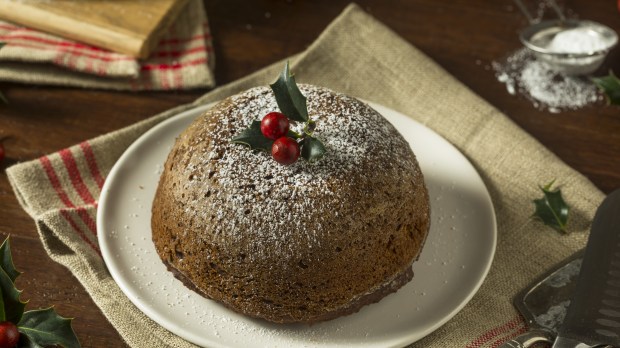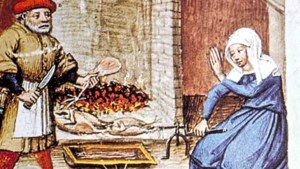The familiar Christmas carol, “We Wish You a Merry Christmas,” which demands, “Oh, bring us some figgy pudding,” and even threatens, “we won’t go until we get some,” leaves us wondering what’s the fuss about figgy pudding.
The traditional British yuletide dessert dates back to the Middle Ages. The 14th-century cookbook The Forme of Cury includes a recipe for “fyge”:
Take blanched almonds, grind them, mix with water and wine, quartered figs, whole raisins. Add in powdered ginger, clarified honey, boil it well and salt it, and serve.
According to English Heritage, “The pudding we know today began life as a pottage. This was a kind of broth, including raisins and other dried fruit, spices and wine.”
By the 15th century, the recipe for “figee” had come to sound a bit more like a more solid boozy, brown dome we assume the Christmas carol is talking about. Today, a figgy pudding, commonly called a “Christmas pudding,” has no figs. The Great British Baking Show’s Prue Leith’s recipe calls for raisins, currants, dried cranberries and brandy.
Christan meaning
But did you know that tradition tells us the recipe for a fig pudding is full of Christian symbolism?
According to English Heritage, it wasn’t until the 18th century when the pudding came to be associated with Christmas. Victorians then established the “Stir Up Sunday,” on the last Sunday before Advent.
Each member of the family would stir the pudding from east to west in honor of the the journey of the Magi. By Christmas, the treat was fully fermented and ready to enjoy.
The pudding itself, according to an NPR report, was traditionally made with 13 ingredients, symbolizing Jesus and the 12 Apostles. It was served with a sprig of holly on top, which represented Christ’s crown of thorns.
In dramatic fashion, the alcohol-filled dessert was then lit on fire, symbolizing the Passion of Christ. It’s no surprise that when Puritans came to America, they left the tradition of the boozy conflagration behind them, and why Americans are more likely to see cheesecake on their table at Christmas.


